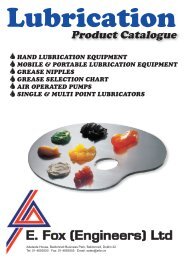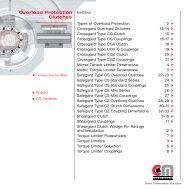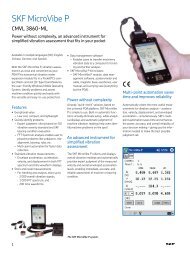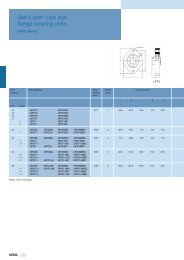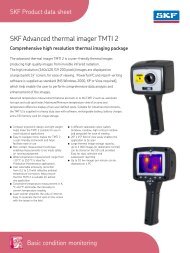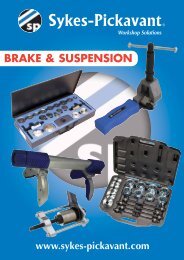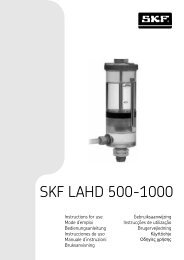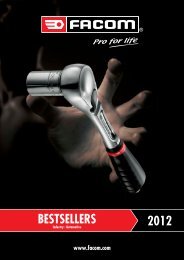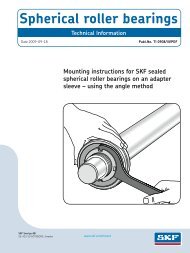PDF catalog - Who-sells-it.com
PDF catalog - Who-sells-it.com
PDF catalog - Who-sells-it.com
You also want an ePaper? Increase the reach of your titles
YUMPU automatically turns print PDFs into web optimized ePapers that Google loves.
Chain Lubrication<br />
CROSS+MORSE<br />
Lubrication Systems<br />
An adequate supply of lubrication is necessary to ensure a<br />
satisfactory wear life for any chain drive. Roller chain when<br />
supplied is coated in a heavy petroleum grease to provide<br />
protection until installation. For some slow, light load applications<br />
this lubrication is adequate providing a short wear life can be<br />
accepted, but for the major<strong>it</strong>y of applications an oil lubrication<br />
system to provide further lubrication will be required, the type<br />
being dependant on chain size, loads and operating speed.<br />
When oil is applied to a roller chain a separating wedge of fluid is<br />
formed in the operating joints, similar to journal bearings, thereby<br />
minimising metal to metal contact. When applied in<br />
sufficient volume the oil also provides effective cooling and<br />
impact dampening at higher speeds. Chain life will vary<br />
appreciably depending on the lubrication system used, and<br />
therefore <strong>it</strong> is important that lubrication re<strong>com</strong>mendations are<br />
<strong>com</strong>plied w<strong>it</strong>h.The chain rating tables used for selection only<br />
apply for drives lubricated in line w<strong>it</strong>h the following<br />
re<strong>com</strong>mendations. Chain drives should be encased for protection<br />
from dirt and moisture, and oil supplies should be kept free of<br />
contamination. A good qual<strong>it</strong>y, petroleum-based, non detergent<br />
thin oil should be used, and changed periodically (Max. 3000<br />
hours operating life). Heavy oils and greases are not<br />
re<strong>com</strong>mended for most applications, because they are too stiff to<br />
enter the small spaces between precision chain <strong>com</strong>ponents. The<br />
following table indicates correct lubricant viscos<strong>it</strong>y for various<br />
ambient temperatures.<br />
Temperature ˚C Oil Viscos<strong>it</strong>y Commercial Grade<br />
–5 to +5 VG 68 SAE 20<br />
5 to 25 VG 100 SAE 30<br />
25 to 45 VG 150 SAE 40<br />
45 to 70 VG 220 SAE 50<br />
There are four basic types of lubrication for chain drives, the<br />
correct one being determined by chain size and speed. This<br />
provides for the minimum lubrication requirements, but the use<br />
of a higher type (i.e. type 3 instead of type 2) will normally be<br />
beneficial to chain life and performance. The correct type can be<br />
selected from graph below of chain speed against chain size.<br />
Refer to page 6 for chain speed calculation.<br />
m/s<br />
10.0<br />
5.0<br />
4.0<br />
3.0<br />
2.0<br />
1.0<br />
0.5<br />
0.4<br />
0.3<br />
0.2<br />
04 05 06 08 10 12 16 20 24 28 32 40<br />
ISO Chain Number<br />
Type 1 - Manual Lubrication<br />
Oil is applied w<strong>it</strong>h a brush or oil-can at least once every 8 hours<br />
of operation. The volume and frequency of application should be<br />
sufficient to keep the chain wet w<strong>it</strong>h oil and prevent overheating<br />
or discolouration of lubricant in the chain joints.<br />
The use of aerosol-can lubricant is often satisfactory on slow<br />
speed drives. It is important that the lubricant used is of a type<br />
specified for roller chains, most of which include P.T.F.E. or other<br />
add<strong>it</strong>ive to reduce friction.<br />
Caution - Manual types of lubrication must never be applied<br />
while drive is in operation.<br />
12<br />
4<br />
3<br />
2<br />
1<br />
Type 2 - Drip Feed Lubrication<br />
Power Transmission Solutions<br />
Oil drops are directed between the link plate edges from a drip<br />
lubricator. Volume and frequency should be sufficient to prevent<br />
discolouration of lubricant in the chain joints. Precaution must<br />
be taken against misdirection of the drops by wind from the<br />
passing chain.<br />
Type 3 - Oil Bath or Disc Lubrication<br />
W<strong>it</strong>h oil bath lubrication the lower strand of the chain passes<br />
through a bath of oil in an enclosed chain case. The oil level<br />
must be carefully controlled to be between the p<strong>it</strong>ch line and top<br />
of the chain at <strong>it</strong> lowest point. Adequate sump capac<strong>it</strong>y is<br />
required to avoid overheating the oil, as a guide capac<strong>it</strong>y in l<strong>it</strong>res<br />
should at least equal half weight of chain Kg/m. This form of<br />
lubrication is most effective when the lower strand of chain is<br />
the slack strand.<br />
W<strong>it</strong>h disc lubrication the chain operates above the oil level. A<br />
disc picks up oil and slings <strong>it</strong> against a collector plate from which<br />
<strong>it</strong> collects in a trough to drip onto the chain. The disc must be<br />
sized to produce rim speeds between 4 and 40 m/s. Generally<br />
disc slinger systems are only capable of delivering small<br />
quant<strong>it</strong>ies of oil and thus should be restricted to lower power<br />
drives (up to 25 kW).<br />
Oil Bath<br />
Lubrication<br />
Sight Feed Lubricator<br />
Wick-Packed Distributing Pipe<br />
Type A - Drip Feed Lubrication<br />
Slinger Disc<br />
Lubrication<br />
Type 4 - Forced Feed Lubrication<br />
Oil is pressure fed from a circulating pump, or central lubrication<br />
system, via a spray bar, onto the chain. The spray bar should have<br />
holes 3mm dia. pos<strong>it</strong>ioned over the side plates of the chain (see<br />
sketch for drip feed), so as to direct the oil between the side<br />
plates. The spray bar should be located inside the chain loop close<br />
to the driven sprocket and approximately 5cm from the slack<br />
strand of the chain, w<strong>it</strong>h oil holes directed to deliver oil onto the<br />
chain as <strong>it</strong> enters the driven sprocket.<br />
Oil flow rate should be a minimum of 3.5 l<strong>it</strong>res/min per strand<br />
width of chain. Oil reservoir capac<strong>it</strong>ies should be a minimum of 3<br />
times oil flow rate, and lubrication system should include a full<br />
flow oil filter.<br />
For lubrication requirements outside the above re<strong>com</strong>mendations<br />
consult Cross+Morse Engineering Department.<br />
T el +44 121 360 0155 Fax +44 121 325 1079 Email sales@crossmorse.<strong>com</strong><br />
CD Contents<br />
Catalogue Selection INDEX<br />
Transmissions :<br />
INDEX<br />
BACK<br />
NEXT




